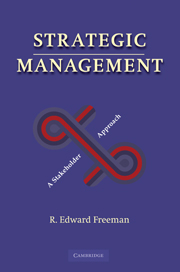Book contents
- Frontmatter
- PREFACE TO THE 2010 REISSUE
- Preface
- Contents
- Part I THE STAKEHOLDER APPROACH
- One “Managing in Turbulent Times”
- Two The Stakeholder Concept and Strategie Management
- Three Stakeholder Management: Framework and Philosophy
- Part II STRATEGIC MANAGEMENT PROCESSES
- Part III IMPLICATIONS FOR THEORY AND PRACTICE
- Bibliography
- Index
One - “Managing in Turbulent Times”
Published online by Cambridge University Press: 05 February 2015
- Frontmatter
- PREFACE TO THE 2010 REISSUE
- Preface
- Contents
- Part I THE STAKEHOLDER APPROACH
- One “Managing in Turbulent Times”
- Two The Stakeholder Concept and Strategie Management
- Three Stakeholder Management: Framework and Philosophy
- Part II STRATEGIC MANAGEMENT PROCESSES
- Part III IMPLICATIONS FOR THEORY AND PRACTICE
- Bibliography
- Index
Summary
INTRODUCTION
Bob Collingwood was President and Chief Executive Officer of the U.S. subsidiary of Woodland International, a large multinational Company headquartered in Europe. Bob was responsible for all of Woodland's activities in the U.S. His functional responsibilities included manufacturing as well as public affairs, as Woodland was fully integrated in its U.S. operations. Bob was measured on profitability as well as several other financial criteria. As he checked his appointment calendar for the upcoming two weeks, he could see that the schedule listed appointments with one external group after another, with agendas ranging from traditional labor-management issues to concerns with Woodland's social responsibility.
On Monday a State legislature in the Northeast where Woodland had major manufacturing facilities would open two days of hearings on a bill requiring companies to notify the State government before moving a plant out of State. A test marketing program for a new product line would be launched on Thursday, and he needed to be involved with the marketing people on some last minute decisions. On Saturday, the leaders of a coalition of consumer organizations would arrive to hear his talk about the merits and safety of several of Woodland's products. And, on Sunday an environmental group was going to hold a demonstration to protest air pollution caused by a Woodland plant.
- Type
- Chapter
- Information
- Strategic ManagementA Stakeholder Approach, pp. 3 - 30Publisher: Cambridge University PressPrint publication year: 2010



